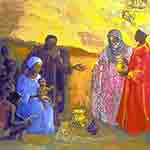
When they saw that the star had stopped, they were overwhelmed with joy. On entering the house, they saw the child with Mary his mother; and they knelt down and paid him homage. Then, opening their treasure-chests, they offered him gifts of gold, frankincense, and myrrh. And having been warned in a dream not to return to Herod, they left for their own country by another road. (Matthew 2:10-12)
ἰδόντες δὲ τὸν ἀστέρα, ἐχάρησαν χαρὰν μεγάλην σφόδρα καὶ ἐλθόντες εἰς τὴν οἰκίαν, εὗρον τὸ παιδίον μετὰ Μαρίας τῆς μητρὸς αὐτοῦ, καὶ πεσόντες προσεκύνησαν αὐτῷ, καὶ ἀνοίξαντες τοὺς θησαυροὺς αὑτῶν, προσήνεγκαν αὐτῷ δῶρα, χρυσὸν, καὶ λίβανον, καὶ σμύρναν καὶ χρηματισθέντες κατ᾽ ὄναρ μὴ ἀνακάμψαι πρὸς Ἡρώδην, δι᾽ ἄλλης ὁδοῦ ἀνεχώρησαν εἰς τὴν χώραν αὑτῶν
the star had stopped – this star does not move like stars normally do.
the house – Matthew’s story has Mary and Joseph living in a house in Bethlehem. He will get them to Nazareth at a later stage.
the child with Mary his mother – an image found throughout Christian history (and prior to Christian history).
paid him homage – the Magi achieve their goal. Homage (προσεκύνησαν) is normally reserved for God.
they offered him gifts of gold, frankincense, and myrrh – three gifts has resulted in a tradition of three Magi. Cf. Isaiah 60:6 “They shall bring gold and frankincense,
and shall proclaim the praise of the Lord.” Are the Magi giving these as gifts to Jesus, or are they giving up tools of the Magi practices? Some note that frankincense and myrrh are similar, and, with gold appearing to be different, these claim that gold doesn’t refer to a metal, but to to a golden spice or balsam oil or similar. It would be great to confirm the claim that “In fact, these same three items were apparently among the gifts, recorded in ancient inscriptions, that King Seleucus II Callinicus offered to the god Apollo at the temple in Miletus in 243 B.C.E.” Others would like to allegorise gold, frankincense, and myrrh to represent king, God, and priest. Gold is well known. Frankincense (Lef 2:1; 14:7; Neh 13:9) originates in South Arabia, Ethiopia, Somalia, and India as resin from the Boswellia tree. Myrrh also comes from a tree from Arabia, Abyssinia, and India. It is resin, gum, and oil and can be in a liquid or solid form. Jews, at the time of Jesus, used it to prepare dead bodies for burial.
having been warned in a dream – dreams play a significant role in this early part of Matthew.
This is the nineteenth post in a series – you can begin here:
Matthew in Slow Motion 1
Matthew in Slow Motion 2
Matthew in Slow Motion 3
Matthew in Slow Motion 4
Matthew in Slow Motion 5
Matthew in Slow Motion 6
Matthew in Slow Motion 7
Matthew in Slow Motion 8
Matthew in Slow Motion 9
Matthew in Slow Motion 10
Matthew in Slow Motion 11
Matthew in Slow Motion 12
Matthew in Slow Motion 13
Matthew in Slow Motion 14
Matthew in Slow Motion 15
Matthew in Slow Motion 16
Matthew in Slow Motion 17
Matthew in Slow Motion 18
As this year the Sunday Gospel readings’ focus is on St Matthew’s Gospel, I thought I’d start some of my personal study and Lectio Divina with that Gospel. [NB. I am using ‘Matthew’ as a convenient term for the author of the first Gospel in the order of the Christian canon].
If you appreciated this post, do remember to like the liturgy facebook page, use the RSS feed, and sign up for a not-very-often email, …




I read an archeological article, many years ago, that made the claim that the oldest form of the Israelite religion was a Trinity, Father, Mother & Child.